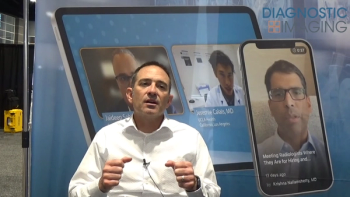
Siemens’ moving table simplifies MR
Playing off the continuously moving table built into TimCT, Siemens Medical Solutions proclaimed “Tim (Siemens’ total image matrix) is on the move” at the International Society for Magnetic Resonance in Medicine meeting in Berlin. The company is featuring clinical results from its seven luminary installations of the technology in MR angiography and central nervous system imaging.
Playing off the continuously moving table built into TimCT, Siemens Medical Solutions proclaimed "Tim (Siemens' total image matrix) is on the move" at the International Society for Magnetic Resonance in Medicine meeting in Berlin. The company is featuring clinical results from its seven luminary installations of the technology in MR angiography and central nervous system imaging.
"With this, MR has come closer to how CT works," said Cecile Mohr, Ph.D., global market segment manager for MR.
The capability, first shown at the 2006 RSNA meeting, is nearing its midsummer commercial release date for both 1.5T and 3T systems. Siemens expects to launch the technology globally in July as both an upgrade and an option on new systems. Installed scanners outfitted with Tim, both the entry-level "I" class and high-end "T" class, will be upgradable to TimCT, according to Mohr.
Where and exactly when these upgrades and new installations will happen will depend on the availability of Siemens service engineers and application specialists in specific countries. Pricing for the option and upgrade has not yet been established.
Siemens is expecting a strong response from its customer base, as TimCT promises to make technologists' lives easier and sites more efficient. Running in MRA mode, its continuously moving table simplifies the planning and conduct of peripheral angiography cases, thereby improving workflow. In FastView mode, TimCT visualizes from the brain to the lumbar spine in one smooth motion.
"You see the table move and the image reconstructed as it goes, just like on a CT," she said.
TimCT absolves the technologist from planning and managing a multistep progression of the MR table, as it would otherwise chase a bolus from station to station or chunk through a CNS study, segmenting the body into several acquisitions. The underlying Tim technology making this possible has up to 102 coil elements streaming data into 32 radiofrequency channels.
Siemens drew booth visitors to TimCT with banners and an iconic sprinter designed to capture the speed the company wants to associate with the new technology. The clinical advantages were exemplified by a series of panels in the booth showing the imaging results obtained at sites in the U.S., Germany, and Hong Kong.
The company, in concert with these luminaries, has developed the basic applications in angiography and CNS imaging, but it continues to explore new ones within and outside of radiology. A prime opportunity may be oncology, according to Mohr. Liver and pelvic imaging for cancer assessment are possibilities.
Newsletter
Stay at the forefront of radiology with the Diagnostic Imaging newsletter, delivering the latest news, clinical insights, and imaging advancements for today’s radiologists.




























